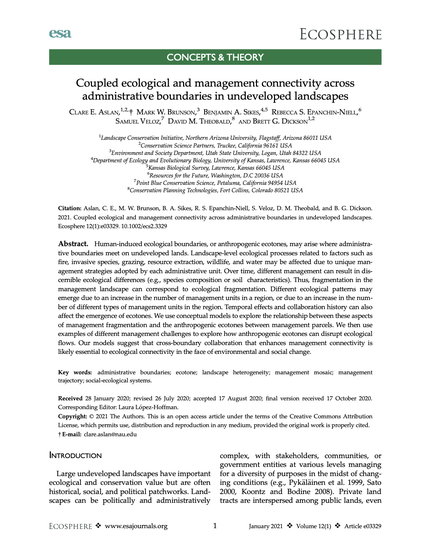
Article
Coupled ecological and management connectivity across administrative boundaries in undeveloped landscapes
Ecosphere
(2021)
Abstract
Human-induced ecological boundaries, or anthropogenic ecotones, may arise where administrative boundaries meet on undeveloped lands. Landscape-level ecological processes related to factors such as fire, invasive species, grazing, resource extraction, wildlife, and water may be affected due to unique management strategies adopted by each administrative unit. Over time, different management can result in discernible ecological differences (e.g., species composition or soil characteristics). Thus, fragmentation in the management landscape can correspond to ecological fragmentation. Different ecological patterns may emerge due to an increase in the number of management units in a region, or due to an increase in the number of different types of management units in the region. Temporal effects and collaboration history can also affect the emergence of ecotones. We use conceptual models to explore the relationship between these aspects of management fragmentation and the anthropogenic ecotones between management parcels. We then use examples of different management challenges to explore how anthropogenic ecotones can disrupt ecological flows. Our models suggest that cross-boundary collaboration that enhances management connectivity is likely essential to ecological connectivity in the face of environmental and social change.
Disciplines
Publication Date
2021
DOI
https://doi.org/10.1002/ecs2.3329
Citation Information
Mark W. Brunson. "Coupled ecological and management connectivity across administrative boundaries in undeveloped landscapes" Ecosphere Vol. 12 Iss. 1 (2021) p. e03329 Available at: http://works.bepress.com/mark_brunson/316/
